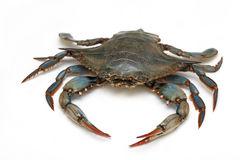Crab
-
Greek crab 220+
 Read More
Read MoreCrabs are prepared and eaten as a dish in several different ways all over the world. Some species are eaten whole, including the shell, such as soft-shell crab; with other species, just the claws and/or legs are eaten. The latter is particularly common for larger crabs, such as the snow crab. Mostly in East Asian cultures, the roe of the female crab is also eaten, which usually appears orange or yellow in fertile crabs.
In some regions, spices improve the culinary experience. In Southeast Asia and Indosphere, masala crab and chilli crab are examples of heavily spiced dishes. In the Chesapeake Bay region, blue crab is often eaten with Old Bay Seasoning. Alaskan king crab or snow crab legs are usually simply boiled and served with garlic or lemon butter.
For the British dish Cromer crab, the crab meat is extracted and placed inside the hard shell. One American way to prepare crab meat is by extracting it and adding a flour mix, creating a crab cake. Crabs are also used in bisque, a global dish of French origin.
Imitation crab, made from minced fish products that are crafted to resemble crab meat, is disdained throughout the culinary industry as an unacceptably low-quality substitute for real crab. This does not hinder its popularity in Japan (where it originated) and in home cooking, where cost is often a chief concern. -
French brown crab 600/800
Read MoreCancer pagurus, commonly known as the edible crab or brown crab, is a species of crab found in the North Sea, North Atlantic Ocean and perhaps in the Mediterranean Sea. It is a robust crab of a reddish-brown colour, having an oval carapace with a characteristic "pie crust" edge and black tips to the claws. A mature adult may have a carapace width of up to 25 cm (10 in) and weigh up to 3 kg (6.6 lb). C. pagurus is a nocturnal predator, targeting a range of molluscs and crustaceans. It is the subject of the largest crab fishery in Western Europe, centred on the coasts of the British Isles, with more than 60,000 tonnes caught annually. Around one third of the weight of an adult edible crab is meat, of which one third is white meat from the claws (see declawing of crabs), and two thirds is brown meat from the body. As food, male edible crabs are referred to as cocks and females as hens. Cocks have more sweet white meat; hens have more rich brown meat. Dishes include dressed crab (crab meat arranged in the cleaned shell, sometimes with decoration of other foodstuffs), soups such as bisque or bouillabaisse, pâtés, mousses and hot soufflés.
-
French brown crab 800+
Read MoreCancer pagurus, commonly known as the edible crab or brown crab, is a species of crab found in the North Sea, North Atlantic Ocean and perhaps in the Mediterranean Sea. It is a robust crab of a reddish-brown colour, having an oval carapace with a characteristic "pie crust" edge and black tips to the claws. A mature adult may have a carapace width of up to 25 cm (10 in) and weigh up to 3 kg (6.6 lb). C. pagurus is a nocturnal predator, targeting a range of molluscs and crustaceans. It is the subject of the largest crab fishery in Western Europe, centred on the coasts of the British Isles, with more than 60,000 tonnes caught annually. Around one third of the weight of an adult edible crab is meat, of which one third is white meat from the claws (see declawing of crabs), and two thirds is brown meat from the body. As food, male edible crabs are referred to as cocks and females as hens. Cocks have more sweet white meat; hens have more rich brown meat. Dishes include dressed crab (crab meat arranged in the cleaned shell, sometimes with decoration of other foodstuffs), soups such as bisque or bouillabaisse, pâtés, mousses and hot soufflés.
-
Crab sticks Surimi
 Read More
Read MoreCrab sticks (imitation crab meat, seafood sticks, krab) are a form of kamaboko, a processed seafood made of starch and finely pulverized white fish (surimi), shaped and cured to resemble the leg meat of snow crab or Japanese spider crab.
